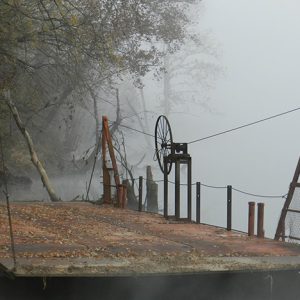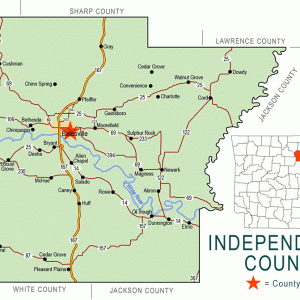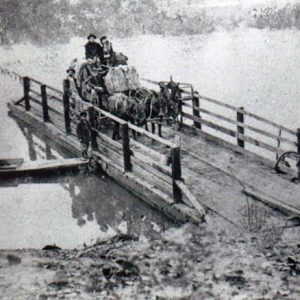calsfoundation@cals.org
O'Neal (Independence County)
The O’Neal Cemetery is all that remains of a once vibrant river and railroad community located across the White River from Marcella (Stone County). Going west on Highway 106 through Bethesda (Independence County), the O’Neal Road leads to O’Neal, which is about four miles from Bethesda. In territorial days, O’Neal was in Ruddell Township, but it later became part of Washington Township. O’Neal lies on both the Union Pacific Railroad tracks and the White River, south of Lock and Dam No. 3. The rich bottomland around O’Neal is still farmed on both sides of the river. O’Neal is about twelve miles west of Batesville (Independence County), the county seat.
O’Neal was founded and first settled during territorial days by John O’Neal, his wife, Nancy Harbour O’Neal, from Kentucky, and by Abijah O’Neal believed to be John’s brother. Since Abijah first lived on the land that became O’Neal and was still living there at the time of his death in 1868, the family believes that the community is named for him. The O’Neal family was living on the White River bottomland by 1830. The O’Neal family established close ties with the Thomas Elms family from across the river in Locust Grove (Independence County). Elms was also one of the early settlers from Kentucky. Four marriages between the O’Neal and Elms family bound them together.
In 1845, Nancy Harbour O’Neal inherited 545 acres of land in Washington County, Texas, from her father. John and Nancy O’Neal and their younger children moved to their inherited land in Texas in late 1846; most of the older married children soon followed. The only grave that has been identified in the abandoned and neglected O’Neal Cemetery is that of Phoebe O’Neal, one of Abijah’s daughters, who married Lytle Buford Creswell of the pioneering Creswell family of Izard County. She died in 1851 at the age of twenty-seven.
Steamboat travel on the upper White River, north-northwest of Jacksonport (Jackson County), began in 1831. Across the river from John O’Neal’s farm lay Hess Town (today Marcella), named after the founder Sam Hess, who had settled in Ruddell Township from Kentucky.
The ferry that crossed the White River to the O’Neal bottoms was owned and operated by Charles Bingham Grigsby and was called the Grigsby Ferry, but later became known as the O’Neal Ferry, named for the community. The Hess Ferry was located just upstream from the Grigsby Ferry.
O’Neal has considerable Civil War history. According to the Hess family, troops were deployed out of Hess Ferry, which was used as a Confederate recruiting station. The Union was determined to gain control of the White River valley and O’Neal because of the ferry. As a result of its strategic location on the upper White River, the community played a key role in the skirmishes in the county. Crossing the ferry was part of the alternate route for the military road to Mount Olive (Izard County) and Yellville (Marion County) and on to Kansas City, Missouri. During the Skirmish at Knight’s Cove on June 19, 1862, the Grigsby ferry was purposely sunk by the Confederate commander William Chitwood in collusion with the owner Charlie Grigsby, but the ferry was quickly rebuilt by the Union forces under Lieutenant Ferdinand Hansen. The community of O’Neal was caught in the middle of two of the main confrontations between Union and Confederate troops in Independence County: the February 19, 1864, Skirmish at Waugh’s Farm and the May 25, 1864, Skirmish at Buck Horn across the river.
After the Civil War, railroads began to replace steamboats as freight haulers and providers of passenger travel. The St. Louis, Iron Mountain and Southern Railway was completed from Batesville to Cotter (Baxter County) following the north bank of the White River by fall 1903, and daily passenger service from Newport (Jackson County) to Batesville to Cotter was available, with the train going through O’Neal. The tracks were extended to Carthage, Missouri, by 1906.
A post office named Grigsby was established in 1902 and renamed O’Neal (spelled Oneal by the U.S. Postal Service) in 1905 with the coming of the railroad. Thomas Smith Compton was appointed the first postmaster. Compton was a brother-in-law of Lottie Jeffery, whose family founded Mount Olive in Izard County. Compton’s nephew, Marcus Compton, married Amanda Della Grigsby, whose parents built the noteworthy Grigsby house of Bethesda around 1867; it has since been relocated to the campus of Lyon College in Batesville. Amanda’s father, Charles Bingham Grigsby, also owned and operated the ferry and had a trading post at O’Neal. The O’Neal Post Office closed in 1943.
The O’Neal School, built in the early 1900s, was located near where Garcia Lane and Copperhead Road intersect today. By the late 1940s, O’Neal had merged with the Bethesda School, and the building was sold for lumber.
Eventually, with trucks replacing trains as major freight haulers, and with Batesville and its industry overshadowing tiny O’Neal, the farm community disappeared.
For additional information:
Adams, Walter M. The White River Railway, Being a History of the White River Division of the Missouri Pacific Railroad Company, 1901–1905. North Little Rock, AR: Walter M. Adams, 1991.
Huddleston, Duane, Sammie Cantrell Rose, and Pat Wood. Steamboats and Ferries on the White River: A Heritage Revisited. Fayetteville: University of Arkansas Press, 1998.
Mobley, Freeman K. Making Sense of the Civil War in Batesville–Jacksonport and Northeast Arkansas. Batesville, AR: Frank K. Mobley, 2005.
McAdams, Virginia. “The Battle of Waugh’s Farm.” Independence County Chronicle 2, no. 4 (1961): 3–6.
O’Neal, W. B. “The Place Called O’Neal.” Independence County Chronicle 2 (April 1961): 34–41.
Kenneth Rorie
Van Buren, Arkansas
 Hess/O'Neal Ferry
Hess/O'Neal Ferry  Independence County Map
Independence County Map  O'Neal Ferry
O'Neal Ferry 




Comments
No comments on this entry yet.